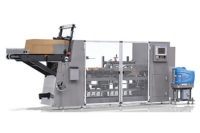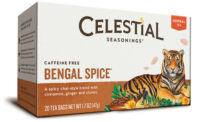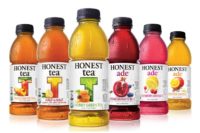Beverage-Makers Get Stuck on Customized Labels
By ELIZABETH BREWSTER
Thinner labeling materials and labeling styles are
providing new options
With a wave of
technological advancements that make it possible for beverage labels to be
more customized than ever before, it’s no surprise that beverage
companies are banking on creative ways to stand
out from the crowd. And thanks to more versatile labeling equipment,
thinner labeling materials and faster applications, a variety of labeling
styles and materials are making new inroads into traditional industry
segments.
“We’re starting to see a lot more complex
graphics, with the addition of a lot more process work, more metallics and
those types of things,” says Dan Muenzer, vice president of marketing
for Spear USA, a Cincinnati-based supplier of film pressure-sensitive
labeling systems.
“We’re seeing more sub-surface printed
graphics with laminated construction. The advantage from a cost standpoint
is that with big volumes, the most economical way to print labels is
gravure printing,” he adds. “And with laminated construction on
a gravure press, you can introduce metallics. The metal particles
automatically sink to the bottom, and it increases the shine or sheen of
the metallic you’re trying to print.”
“Paper has been around forever, and it’s
kind of old and maybe a little dated,” adds Sharon Lobel, president
and chief executive officer of Seal-It Inc., Farmingdale, N.Y., which
manufactures shrink labels for the food and beverage industries.
“With heat shrink, you can have 360-degree graphics. The colors are
vibrant and nothing sells your product better than that.”
More flexibility
Beverage manufacturers have four main options for
labeling their products: cut-and-stack, full-wrap hot-melt or
spot-cold-glued film or paper labels; roll-fed, usually made with laminated
film constructions; pressure-sensitive; and shrinkwrap. Today, the major
labeling machine manufacturers are building equipment with modular labeling
capabilities, Muenzer says. One machine may have the ability to apply
pressure-sensitive, cut-and-stack and roll-fed labeling, so beverage
manufacturers don’t need to dedicate an entire filling line to one
method.
Although individual beverage segments have
traditionally stuck with the same kinds of labeling materials year after
year, that’s changing as technology has removed some of the cost and
speed barriers, Muenzer says.
In the beer category, for example, the traditional
paper label may be making way for pressure-sensitive labels, thanks to the
leadership of Anheuser-Busch.
“When Bud Light converted to pressure-sensitive
in 2004, it started a domino effect,” Muenzer says. “The clear,
no-label look is viewed as contemporary... [Now] there is
[pressure-sensitive] application equipment that is fast enough to go on
beer and soft drink lines. You can apply it right on the filling lines, and
that helps take cost out of the system. When you look at the total cost of
a system, the slight up-charge for
[pressure-sensitive] labeling is offset by efficiencies.”
Thin is in
The upfront price difference between paper and film is
one of the reasons that beverage-makers who like the look of film may be
reluctant to try it, says Lane Gravley, process development manager for
Precision Press Inc., Mankato, Minn.
“Most of our focus over the last nine months has
been opaque and clear films,” he says. “But if [beverage
companies] are used to paper labels, film pricing can be about double. They
want to put films on their bottles, but it’s a major leap in
price.”
Adds Precision Press sales manager Beth Backstrom:
“[Some beverage companies] may have cut-and-stack technology, but
they like the look of those shrink-sleeves or film substrates that look
shinier, brighter, more contemporary.”
Gravley says beverage companies are also looking for
thinner films, and Precision is working on getting films below 2.5 ml.
while maintaining faster line speeds in a cut-and-stack environment.
“The thinner films don’t hit that 1,000 to
1,200 bottles-a-minute range at this point. That’s futuristic for
us,” he says. “The film doesn’t have enough rigidity to
it. A bundle of paper labels has a nice, hard, firm surface, but film
labels are spongy.”
Spear USA’s Muenzer agrees that down-gauging is
the wave of the future. “We’re rolling out construction in 1.5
ml., and we’ve done application tasks on less than 1 ml. that have
been successful,” he says. “One of the advantages of going
thinner is that it can take some of the cost out of the process because
you’re using less material. And it helps the label really disappear
on the bottle — the thinner it is, the more it looks like it’s
painted on the bottle.”
Shrinking sleeves
Beverage manufacturers who work with shrink-sleeves
are also looking to down-gauge their materials as the market matures,
according to Alcyr Coelho, vice president of marketing and sales for the
Americas at PDC Europe, Austin, Texas.
“Sixty microns is typical, but [beverage
companies] want to use 40 or even 35 microns now,” he says.
“Forty microns is out there — some machines can apply it, some
cannot. It depends on the way you apply shrink-sleeves. ”
Coelho also singles out enhanced stretch material as
another big trend in shrink sleeves. “Stretchability used to be 8 to
10 percent,” he says. “Now there are new materials with 25
percent stretchability. You can do some contouring that you could not do
before.”
The first commercial application of an enhanced
polyethylene stretch sleeve is Nestle Waters North America’s Aquapod
bottle, says Coelho. The bottle — available only at Target stores in
the Midwest until June, when distribution may be expanded — is designed for children six and older to encourage
them to drink more water.
“It’s an egg-shaped bottle they use in
Europe, and now they’re bringing it to the United States,” he says. “They’re using a sleeve with
25 percent elasticity, a sleeve that follows the contour — but
it’s a polyethylene sleeve.”
The enhanced stretch material has the potential for
the same applications as roll-on shrink OPP (oriented polypropylene), says
Coelho, but without shrink tunnels. “That’s a big savings of
energy and a big savings of space on your line,” he adds.
Also making strides into
the marketplace is OPS (oriented polystyrene), as Wal-Mart and other large
companies try to discourage manufacturers from using PVC (polyvinyl
chloride), says Andy Sharp, president of Packstar Flexible Packaging,
Amherst, N.Y.
“With OPS coming to our market now, it helps
bring the cost of an alternative to PVC closer to the cost [of PVC],”
he says. “It’s helped companies in America use something other
than PVC. I think that trend will continue in our market.” BI
Kicking the petroleum habit
Polyactic acid (PLA) doesn’t exactly roll off
the tongue, but this new biopolymer that Cargill developed from corn is
destined for big things in biodegradable labeling, predicts Andy Sharp,
president of Packstar Flexible Packaging, Amherst, N.Y.
“It’s a real hot and interesting new
resin. I really think it’s going to get some teeth and move quickly
in our industry,” Sharp says. “Right now, no one has really
come out and launched a PLA label for a primary label, but we’re
working with several companies on it. I think in 2006 you will see more
primary labels in PLA form for beverages.”
NatureWorks LLC, a wholly owned subsidiary of Cargill,
produces and sells the PLA resin, which is derived entirely from the sugar
found in maize. Plastic Suppliers Inc., Columbus, Ohio, markets compostable
EarthFirst PLA film made from NatureWorks PLA in both white and clear, and
it can be used in cut-and-stack or pressure-sensitive applications. Its
breathability allows the underlying adhesive to dry through the label, and
it is glossy with a high modulus (stiffness) and a high MVTR for fast
adhesive drying. In fact, it has a higher stiffness than polypropylene, so
it can be better dispensed at much thinner gauges.
NatureWorks PLA benefits from the stability of maize
prices, compared with petroleum-based polymers such as PET. In fact, it has
been price competitive with PET for the past 16 months, according to the
company, and in some cases is now cost-advantaged.
Sharp says the only drawback to PLA film is that it
can get brittle in conditions where the temperature is below zero.
“It’s maybe not as strong as polyester,
but it has all the other nice features of shrinks,” he says.
“It also has nice clarity — it gives you a nice pop on the
color.”
Adds Sharp: “In today’s world, when people
are concerned over oil and usage of fossil fuels, this is something where
we truly can utilize our own natural resources to make a packaging
item.”
Many happy returns
Returnable beverages are the exception rather than the
rule in the United States, but overseas it’s a different matter. So
when Spear USA’s regular pressure-sensitive labels clung stubbornly
to bottles in returnable streams, the Cincinnati-based company opted for
two different solutions: Labels that wash off no matter what, and labels
that stay on no matter what.
Last fall, Spear introduced a wash-off,
pressure-sensitive material for returnable beverages. It looks like a
traditional clear pressure-sensitive label, but when it goes through the
caustic wash cycle, says Dan Muenzer, Spear USA vice president of
marketing, the label curls off the bottle and washes away.
“It’s designed to process exactly like
paper,” Muenzer says. “We’re doing tests in South
America, and the first market applications will be with Carlsberg in Turkey
and Romania.”
Spear is also in the process of commercializing a
multi-trip pressure-sensitive label for the returnable beverage market,
designed to stay on the bottle through the 30 or 40 wash cycles that most
returnables go through.
“It would be a direct replacement for applied
ceramic label (ACL),” Muenzer says. “It would be really big for
Mexico, where they still do a lot of ACL, and also portions of South
America and some countries in Europe.”
Like Spear, CCL-Pachem features a clear wash-off label
for refillable glass bottles that it has found popular in markets abroad.
The labels are designed to shrink and peel off the bottle in temperatures
higher than 75 degrees, allowing them to be removed using industrial bottle
washers. The label remains floating in the water and can be removed
mechanically from the machine.



